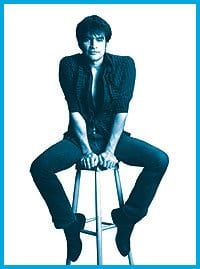He’s played countless dashing lovers, dastardly princes, impish boys and abstract emotions made flesh in works across the repertoire – from old-school classics to avant-garde modern. With his matinee idol looks and name, ballet star Rex Harrington is celebrated for versatility, strength, acting, great partnering and that ineffable something – star power. It’s not just that he can dance the steps, he makes roles come alive for audiences, enlisting them in the great wordless theatre that dance can be.
“There’s a certain sort of thing, an it,” says Harrington. “You can’t teach it. You have to have it. I don’t know where it comes from, tortured childhood, whatever you need, to pull it out of you.
“Thank God I have that. And when I was younger, I had way too much of it. I mean, you just pare it down now – less is more. But that’s the saddest part of getting older in this business: When you finally really realize what you’re doing, your body says unh-uh.”
Harrington is retiring as a principal dancer at 41, after 20 years with the National Ballet Of Canada.
The story of Harrington’s sideways entrée to dance is heartbreaking. From the start, he had tremendous inner strength, something bred in the bone, keeping him literally and figuratively on his feet, propelling him forward.
Born in Peterborough (“that’s just some place on a birth certificate; I never really lived there”), his parents divorced when Harrington was young. His mother was mentally ill; his father got custody. But Harrington ran away from his father when he was 14, to Vancouver and the mother he adored. She enrolled him in dance classes; she wanted her children to be artists. Almost immediately, Harrington won a spot at the National Ballet School on raw talent and chutzpah alone.
His mother was supposed to follow him to Toronto. She didn’t. The school only found out mid-year that the 14-year-old was living on his own, moving him quickly into the school residence. “I don’t see anywhere as home,” Harrington says. “I guess the school was sort of home.”
He eventually lost all contact with his mother. Until just recently. After all this time, he has an address for her. But he’s yet to figure what he’s going to do.
“Dancing wasn’t my idea; it was my mother’s. It was her dream. I went along with it for a while until I realized I was good at it, was able to do it, that I enjoyed it.”
There’s some terrifying logic at work: A dream that comes true through its own sadness.
Harrington’s talents were immediately recognized. His road to stardom was steep and fast.
Former prima ballerina Karen Kain repeats an oft-told story. She missed the NBS’s year-end performance in 1981, the year Harrington graduated. But her husband saw it. “He said, ‘There’s this young man you should see. He’d be a great partner for you. He’s got it all: looks, style, strength and charisma.'”
Two years later, he was part of the company and partnering with Kain. “From the first rehearsal, I could tell he was someone special,” says Kain. “He has the instinctive intuition for partnering, the God-given reflexes required.
“And of course, he was devastatingly handsome – still is – with his dark hair and pale blue eyes.”
“Dancing sort of became real once it was a job,” Harrington says. “I remember the first day walking in the studio, standing there with Owen [Montague] at the barre, with Karen and Frank [Augustyn], all these people you’ve watched for years. It was pretty cool.”
There was no turning back. He quickly rose through the ranks, promoted to principal in 1988, winning kudos along the way.
One of his first international coups was in 1986 when he created the role of Lewis Carroll in Glen Tetley’s Alice. “That was sort of my coming out to the world theatrically, because it was New York and Anna Kisselgoff [the New York Times dance critic] gave me that moniker of instant matinee idol and superstar in the making and so that sort of sent me on my way, critically.
“I remember being backstage at the Met and thinking, ‘I’ve made it.'”
“He’s the first male dancer who’s had longevity and achieved an international career,” says Kain. “He had the perseverance, tenacity and smarts to hang in there. There have been flashes of brilliance from others but there’s only one Rex.”
Harrington also counts as highlights his many appearances at AIDS galas.
The dance community was devastated by AIDS and Harrington lost many friends and colleagues, including his first love, NBC soloist Greg Osborne in 1994.
“I remember when Tommy Tune came [for Toronto’s Dancers For Life] and did this wonderful little soliloquy. He talked about his friends who have died and the impact of AIDS on the community at the time. He said, ‘You know, we’re dancers and we’re artists… I just kind of smile and keep dancing.’ He kind of tapped backwards and the lights went out, the curtain went up and I was standing there. I was crying because I was listening to him and thinking about people I’ve lost and Greg. So that was pretty hard.
“But I was always proud to be there, too, to carry on and support people who are afflicted.”
***
This anniversary season is tailor made to celebrate Harrington and his career, beginning with the ballet most associated with him, Onegin. “It’s truly the ballet I’ve done most in my career.” The ballet’s title character is a jaded sophisticate who rudely spurns the adoring affection of a naïve country girl, Tatiana, after she writes him a letter declaring her love. Later Onegin realizes that he’s lost his one chance at happiness.
“I’ve danced with probably more than 15 different Tatianas: from Carla Fracci at 60 to Alessandra Ferri to [Xiao] Nan [Yu] when she was 20. It’s run the gamut from little ones, Evelyn Hart was the first Tatiana I had, to a huge girl, bigger than Karen Kain, in Italy.”
John Cranko created the ballet in 1965. He once told the New Yorker, “I see Onegin as a myth. Myths have double meanings. Onegin is a young man who has everything – good looks, money, charm – and yet he adds up to nothing. Which makes him terrifying. His problem is a very contemporary one – lack of recognition.”
“Now I’m at the age when it is right for me for me to be doing this ballet,” says Harrington. “When I first did it I was too young. I’ve lived a life; I’ve got the pain. I’ve got the understanding of who this man is. I did it before but it wasn’t layered, it wasn’t nuanced and I never really understood it. Now I have such a joy in finding moments and acting them.I just think it’s going to be great.
“And Nan is five years older [than when she debuted]; she’s more experienced – it was the first full-length she did. And now she’s exquisite. So I’m really looking forward to it.”
(The story comes from Pushkin’s famous novel in verse, Eugene Onegin. Tchaikovsky composed his operatic masterpiece Onegin when his life presented an eerie mirror image. He had received a letter from an adoring woman the same month someone suggested he turn Pushkin’s story into an opera. Unlike Onegin, Tchaikovsky, a tortured homosexual, weds the woman but flees the marriage soon after. The musicfor the ballet is Tchaikovsky’s, but not from the opera; it’s comprised of lesser-known works arranged by Kurt-Heinz Stolze.)
Running in rep is a mixed program that includes the world premiere of Matjash Mrozewski’s Monument, Dominique Dumais’ One Hundred Words For Snow, James Kudelka’s There, Below and excerpts from Kudelka’s The End and Gazebo Dances; the latter sees Harrington paired with Evelyn Hart, the ballerina with whom he’s been dancing from the very start.
“James programmed Gazebo Dances because he wanted to bring Evelyn in for my last year. It’s an unusual work. I’m not sure about it yet. It’s based on 9/11. The whole pas de deux, Evelyn has her hand over one eye and I have one hand over my mouth, based on all the photos he saw of people reacting to the buildings falling. It’s got a real urgency. It should be interesting; it’s a very unique piece.”
Other works with Harrington this season include Kudelka’s Cruel World and Four Seasons (one of Harrington’s favourites), George Ballanchine’s Serenade and Tetley’s Alice.
Before Karen Kain retired, she toured cross the country in a ballet made especially for her, The Actress. Not so for Harrington. “No. I don’t get the Mounties and the limo and the Garth Drabinsky paycheque,” the triple Scorpio says, mischievously. “I don’t get to finish my basement.”
Quickly amending his quip, he adds: “I guess Four Seasons – we did the western tour – that was sort of my bye-bye. The audiences were great and it was nice to be out there. I got the hat and the key everywhere. It was cute.
“This is enough. I’m looking at it for what it is, a really great season. I’m happy to do the ballets that I love.”
The Order Of Canada holder leaves the spotlight satisfied with his accomplishments and eager to start anew. “I’m proud of the company. I’m proud of being a part of the company. I’ve watched it grow. I’ve watched it change. I’ve been through a lot of directors. And things are clicking. I’ve been everywhere else and I look around and I think we’re pretty damn good.”
He’s been enjoying a new role as ballet master, instructing the company on works he knows inside out. He’ll probably take on less physically challenging character roles with the National and he’s signed with an agent to go after acting gigs. “Maybe the fact that I’m Rex Harrington, people are going to be curious and give me five lines. And maybe I’ll be crap and maybe I’ll be brilliant. But I think anything I’ve set out to do I’ve usually made happen.”
After the recent break up of his last relationship and the collapse of the country idyll of boyfriend, dogs and a farm (formerly owned by Timothy Findley), Harrington finds himself as he was at the beginning of his career, alone – great danes and good friends notwithstanding. This time he’s moving forward on his own terms.
MONUMENT, HUNDRED WORDS GAZEBO DANCES.
Thu, Nov 13-19.
ONEGIN.
Sat, Nov 22, 26-30.
$35-$121.
Hummingbird Centre. 1 Front St E.
(416) 345-9595.


 Why you can trust Xtra
Why you can trust Xtra


